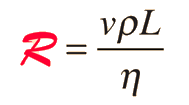Turbulent Flow
Flow descriptions such as Poiseuille's law are valid only for conditions of laminar flow. At some critical velocity, the flow will become turbulent with the formation of eddies and chaotic motion which do not contribute to the volume flowrate. This turbulence increases the resistance dramatically so that large increases in pressure will be required to further increase the volume flowrate. Experimental studies have characterized the critical velocity for a long straight tube in the form

which depends upon the viscosity η in poise, the density ρ in gm/cm3 , the radius of the tube r in cm. The script R is an experimental constant called the Reynold's number. The reported Reynolds number for blood flow is about 2000. Modeling blood flow in the human aorta according to this criterion leads to the expectation of some turbulence in the center of the flow.
Poiseuille's law concepts
| HyperPhysics***** Mechanics ***** Fluids | R Nave |



